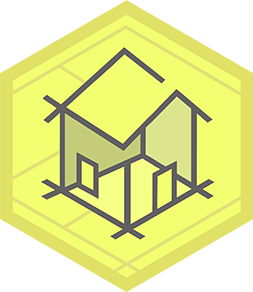Make a Background For Your Architectural Setup
Create a painted backdrop for your model buildings using cardboard, paint, paper, and glue to practice scale, perspective, and texture.



Step-by-step guide to make a background for your architectural setup
Step 1
Gather all your materials on a clear table so everything is within reach.
Step 2
Arrange your model buildings in front of the table to see how wide and tall the backdrop needs to be.
Step 3
Measure the cardboard to match the size you need and mark the cutting lines with your ruler and pencil.
Step 4
Cut the cardboard along your marks to make the backdrop base.
Step 5
Reinforce the cardboard edges and fold lines with masking tape so the backdrop stands up well.
Step 6
Lightly draw a horizon line and one or two vanishing points to guide the perspective.
Step 7
Mix the paint colors you want and put them on a palette or plate.
Step 8
Paint a base coat for the sky and ground using broad strokes to cover large areas.
Step 9
Add atmospheric perspective by making distant colors lighter and less detailed to show depth.
Step 10
Use a sponge or crumpled paper dipped in paint to dab texture for trees clouds or rough surfaces.
Step 11
Paint small distant building silhouettes and tiny details with a thin brush to show scale.
Step 12
Glue on a few cut-paper layers for foreground elements to create extra depth.
Step 13
Let the backdrop dry completely before moving it.
Step 14
Place your model buildings in front of the backdrop and make small touch-ups to fit the scene.
Step 15
Share a photo of your finished backdrop and architectural setup on DIY.org
Final steps
You're almost there! Complete all the steps, bring your creation to life, post it, and conquer the challenge!


Help!?
What can I use if I can't find corrugated cardboard or masking tape?
Use foam board or a large poster board (or layer and tape together cereal boxes) for the backdrop base and substitute painter's tape or clear packing tape where the instructions say to 'Reinforce the cardboard edges and fold lines with masking tape'.
My backdrop keeps flopping over—how do I stabilize it?
If the backdrop won't stand after you 'Reinforce the cardboard edges and fold lines with masking tape', glue or tape a folded cardboard kickstand to the back or weigh the bottom edge with books or a strip of tape along the table.
How can I adapt this project for different ages?
For younger children pre-measure and pre-cut the cardboard and let them dab texture with a sponge as described in 'Use a sponge or crumpled paper dipped in paint', while older kids can draw horizon and vanishing points, mix paints, paint atmospheric perspective, and glue on cut-paper layers themselves.
How can we make the backdrop more detailed or unique?
Enhance the scene by adding LED fairy lights behind the painted horizon, using crumpled foil for extra texture before painting, adding tiny window highlights with the thin brush as in 'Paint small distant building silhouettes', and personalizing the foreground with photos or stickers before you 'Place your model buildings in front of the backdrop'.
Watch videos on how to make a background for your architectural setup
Architectural Design Process Explained
Facts about architectural model-making for kids
🏛️ Architectural models let architects test ideas at a smaller size—famous designers like Frank Lloyd Wright used them to visualize plans.
🎨 Cool colors (blues, greens) appear to recede while warm colors (reds, yellows) advance—use this to create depth in a backdrop.
📦 Corrugated cardboard is lightweight, strong, cheap, and recyclable, which is why it's a go-to material for mock-ups and backdrops.
🧩 Just a few perspective lines plus texture from sponge-painting or torn paper can make a flat board read as a realistic city skyline.
📏 Scale ratios such as 1:50 or 1:100 are common for building models; dollhouses often use a 1:12 scale.
How do I make a painted backdrop for my architectural model setup?
What materials do I need to create a backdrop with cardboard, paint, paper, and glue?
What ages is making a painted backdrop for an architectural setup suitable for?
What are the benefits of creating a painted backdrop for model buildings?


One subscription, many ways to play and learn.
Only $6.99 after trial. No credit card required



